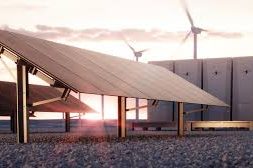
Govt allocates Rs 455 crore for green hydrogen pilot projects in steel sector – EQ
In Short : The government’s allocation of Rs 455 crore for green hydrogen pilot projects in the steel sector indicates a significant investment in promoting sustainable and low-carbon technologies. This funding aims to support the development and implementation of green hydrogen initiatives within the steel industry, aligning with India’s broader goals of reducing carbon emissions and fostering a cleaner energy landscape.
In Detail : The Centre’s schemes for the power sector, including renewables, have received an allocation of at least Rs 28,352 crore in the Interim Budget 2024, up 50 percent from the revised estimate (RE) of Rs 18,945 crore in 2023-24, an analysis showed.
While the National Green Hydrogen Mission (NGHM), Bio Energy initiative and hydroelectric projects were the top three gainers, schemes aimed at reforming the power distribution sector also received at least a 39 percent higher budgetary allocation.
Also read: Budget 2024 on Green Energy: Rooftop solar, offshore wind, coal gasification, biomass get boost.
Wind energy is the only sector that saw a downward revision in the budget, despite Union Finance Minister Nirmala Sitharaman announcing a viability gap funding (VGF) for offshore wind of up to 1 gigawatt (GW) capacity without specifying the amount. Senior officials in the Ministry of New and Renewable Energy (MNRE) said offshore wind is yet to take off in the country, which is why actual budgetary allocation will happen at a later stage. “Provisions can be made later in FY25 if required, but offshore wind is still at a nascent stage. Bids for the non-VGF seabed allocation have been called this month. The VGF bids are likely later in FY25,” said an official who did not want to be named.
When seen separately, renewable energy schemes (under MNRE) were allocated Rs 12,491 crore, up 65 percent from Rs 7,586 crore in RE 2023-24. Power sector initiatives (under the Ministry of Power) got a 40 percent hike from Rs 11,359 crore to Rs 15,861 crore.
Green Hydrogen
Much has happened in a year since the NGHM was approved by the Union Cabinet on January 4, 2023. Budgetary allocation for NGHM increased to Rs 600 crore from Rs 100 crore in the revised estimate for 2023-24. This is because the government not only intends to begin a few pilot projects, but is also inching closer to finalising the winners for its incentive schemes.
Also read: Energy Budget: Power PSUs get 17% more budgetary allocation.
Two modes of incentive schemes have been announced – 1. The lowest incentive bid demanded 2. Demand aggregation route. Under Mode 1, Reliance Industries, JSW Energy, Torrent Power and Bharat Petroleum Corp are among 14 companies that have made bids under India’s green hydrogen plan. Besides, 20 companies including Reliance Industries, the the Adani Group, Jindal India, Larsen & Toubro and Bharat Heavy Electricals have also submitted bids for incentives to manufacture electrolysers.
Bio Energy
MNRE is running the National Bioenergy Programme from April, 2021 to March 31, 2026. Funds for this increased 300 percent to Rs 300 crore from Rs 75 crore in RE 2023-24.
Also read: Govt temporarily eases mandate on biomass pellet co-firing in thermal power plants.
The programme has three sub-schemes: Waste to Energy Programme (scheme to generate energy from urban, industrial and agricultural); Biomass Programme (scheme to support manufacturing of briquettes & pellets used by thermal power plants for blending); Biogas Programme.
Hydropower
Hydropower projects have received Rs 51 crore, up 155 percent from Rs 20 crore in RE 2023-24. The 2,000 MW Subansiri Lower project, under construction in Arunachal Pradesh and Assam, is likely to be fully commissioned by December 2024. Besides, two units of the delayed Parbati-II project in Himachal Pradesh will start operations between April and June.
Also read: MC Exclusive | RK Singh vows to double India’s hydropower capacity.
Solar Energy
The budgetary allocation for schemes to promote solar energy touched Rs 8,644 crore, up 75 percent from Rs 4,941 crore in RE 2023-24. This is excluding the Pradhan Mantri Kisan Urja Suraksha Evam Utthaan Mahabhiyan Yojana (PM-KUSUM), aimed at solarisation of the agriculture sector.
The PM-KUSUM scheme also got an enhanced allocation of Rs 1,496 crore, up 36 percent from Rs 1,100 crore.
Miren Lodha, Director- Research, CRISIL Market Intelligence & Analytics said the domestic rooftop solarisation project announced by the FM in her Budget speech on February 1 could translate into capacity additions of 20-22 GW in the residential rooftop segment. “It could result in investments of Rs 91,000-1,10,000 crore. Through this, the overall solar rooftop base is expected to reach 31-33 GW from 11 GW as of December 2023,” Lodha said.
Also read: Pradhan Mantri Suryoday Yojna – Houses consuming up to 300 units to get rooftop solar free.
In her Budget speech, the FM said solar installations in such households will result in savings of about 300 units of electricity per month. “On an annual basis, the scheme could result in savings of Rs 15,000-18,000 for households that install rooftop solar systems,” she said.
Revamped Distribution Sector Scheme (RDSS)
The Centre’s Revamped Distribution Sector Scheme (RDSS), aimed to cover more households with prepaid smart meters and reduce the aggregate technical and commercial (AT&C) losses of the country, got a 39 percent boost from Rs 10,400 crore to Rs 14,500 crore in the Interim Budget.
Also read: Power discoms’ average AT&C losses have reduced to 13.5% in FY23: Power Secretary.
RDSS is meant to be a facilitator to improve the operational efficiencies of discoms and help reduce their losses and make them financially sustainable. The scheme aims to reduce technical and commercial losses pan-India to levels of 12-15 percent by 2024-25 and cut the cost-revenue gap to zero by 2024-25.
Vikram V, Vice President, Co-Group Head – Corporate Ratings, ICRA Limited, said the increased allocation to the distribution sector will help the discoms augment their infrastructure and improve operating efficiencies. Also, the increase in allocation to the RDSS scheme would aid in scaling up smart meter installations, he said.
Green Energy Corridors
Green energy corridors or laying transmission lines for the evacuation of renewable energy saw a 38 percent growth, from Rs 434 crore in 2023-24 (RE) to Rs 600 crore in the Interim Budget 2024. This is significant because India aims to achieve 50 percent cumulative installed power generation capacity from non-fossil fuel sources by 2030.
Also read: Exclusive: PowerGrid can start work on Leh-Kaithal Green Energy Corridor only by 2026
For this, the country needs to add about 50 GW per annum of renewable energy capacity for the next five years, starting in 2024. So far, India has been able to add only about 15 GW each year. Green Energy Corridors are now needed to transmit the green energy produced at renewable energy parks to other parts of the country to meet India’s burgeoning power demand.












